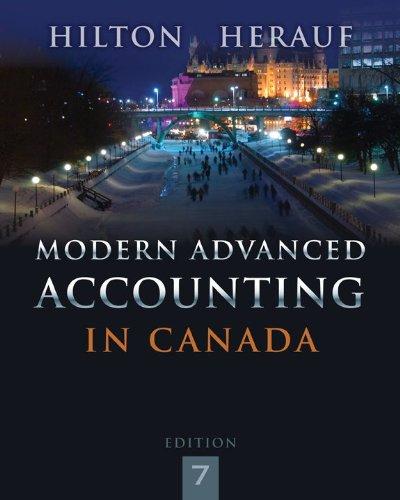Question
Problem 08-13 (LO5) A Company owns 75% of B Company and 40% of C Company. B Company owns 40% of C Company. The following information
Problem 08-13 (LO5)
A Company owns 75% of B Company and 40% of C Company. B Company owns 40% of C Company. The following information was assembled at December 31, Year 7.
A CompanyB CompanyC CompanyCash$119,400$50,900$21,600Accounts receivable232,000132,00060,000Inventory309,000238,00074,000Investment in C75,240110,240Investment in B1,310,730Property,plant, and equipment3,300,0002,600,000270,000Accumulated depreciation(960,000)(577,000)(104,000)$4,386,370$2,554,140$321,600Accounts payable$123,000$104,000$10,000Bonds payable400,000700,000Preferred shares-50,000Common shares1,200,000400,000200,000Retained earnings, January 12,582,5701,229,14075,600Net income134,80071,00036,000Dividends(54,000)$4,386,370$2,554,140$321,600
Additional Information
- A Company purchased its 40% interest in C Company on January 1, Year 4. On that date, the negative acquisition differential of $50,000 on the 40% investment was allocated to equipment with an estimated useful life of 10 years.
- A Company purchased its 75% of B Company's common shares on January 1, Year 6. On that date, the 100% implied acquisition differential was allocated $40,000 to buildings with an estimated useful life of 20 years, and $92,000 to patents to be amortized over eight years. The preferred shares of B Company are non-cumulative.
- On January 1, Year 6, B Company's accumulated depreciation was $450,000.
- On January 1, Year 7, B Company purchased its 40% interest in C Company for $110,240. The carrying amount of C Company's identifiable net assets approximated fair value on this date and C Company's accumulated depreciation was $28,400.
- The inventory of B Company contains a profit of $8,800 on merchandise purchased from A Company. The inventory of A Company contains a profit of $7,800 on merchandise purchased from C Company.
- On December 31, Year 7, A Company owes $36,000 to C Company and B Company owes $4,500 to A Company.
- Both A Company and B Company use the equity method to account for their investments but have made no equity method adjustments in Year 7.
- An income tax rate of 40% is used for consolidation purposes.
Required:
(a)Calculate non-controlling interest's share of consolidated net income for Year 7.(Round your intermediate computations to nearest whole dollar value.Omit $ sign in your response.)
Non-controlling interest's share of consolidated net income$
(b)consolidated statement of retained earnings for Year 7.(Round your intermediate computations to nearest whole dollar value. Input all values as positive numbers.Omit $ sign in your response.)
A CompanyConsolidated Retained Earnings StatementFor the Year Ended December 31, Year 7Balance Jan. 1$Net incomeLess: DividendsBalance Dec. 31$
(c)consolidated balance sheet as at December 31, Year 7.(Amounts to be deducted should be indicated by a minus sign. Round your intermediate computations to nearest whole dollar value.
Step by Step Solution
There are 3 Steps involved in it
Step: 1

Get Instant Access to Expert-Tailored Solutions
See step-by-step solutions with expert insights and AI powered tools for academic success
Step: 2

Step: 3

Ace Your Homework with AI
Get the answers you need in no time with our AI-driven, step-by-step assistance
Get Started


